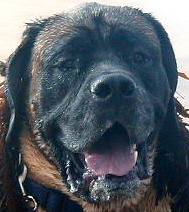It has taken me 10 months to write this: Goya died of cancer in April 2007.
He had recovered to a good quality of life from his long bout with coonhound paralysis -- getting onto the couch himself to lay his head (or butt) in our laps, going up and down stairs (though he looked at the stairs to our bedroom as if it were Mount Everest each night), walking to Starbucks each morning, in short, doing things normal old mastiffs do.
In late March, 2007, he started to limp very badly on his left front leg. His shoulder seemed to swell up rapidly and we thought he might have hurt it coming down stairs or something. We called in the vet and he took one look at Goya, laid his hands on him, and told us that Goya had a very aggressive tumor in his shoulder and that he was in a lot of pain; there was nothing we could do but decide when to end his pain. The vet gave us patches with pain medication (a highly controlled substance in the US; more powerful than morphine) and showed us how to use them to keep him comfortable while we decided what to do and when to do it. This was on a Thursday.
We immediately called the girls, both off at college on different coasts of the US. We redeemed frequent flyer miles so the girls could come home to say goodbye that weekend. Laura managed to stay for 1.5 days; Liza only made it home for about 4 hours. Goya was soooooo happy to see his girls! Cuddling him all the while, we discussed what to do with his body. Gary mentioned that we are all organ donors -- was something like that a possibility for Goya? Maybe someone could study the effects of coonhound paralysis on his body and how he recovered, or something. I pledged to find out and we took the girls to the airport.
The next day, I surfed the web and called the Ohio State Vet School where Goya had been diagnosed. They couldn't help us. Since coonhound paralysis is related to Guillain-Barre Syndrome in humans, maybe the Neurology Department at the University of Pittsburgh PA (near where we live) would want him, so I called there. The wonderful woman who answered the phone said it wouldn't be appropriate for the department to accept a canine cadaver, but that she would spend some time surfing the web to help me find something and she took my phone number so she could get back to me. I corresponded with a researcher who was now retired but used to study coonhound paralysis - he directed me to another researcher who was interested but had no active research program and couldn't help. Seeming dead end. The woman from Pitt's neurology department called me back and told me that she had found the Educational Memorial Programs website -- I might want to look into it.
http://www.educationalmemorial.org/The Education Memorial Progam, UPenn being the nearest to us, was exactly what we were looking for; a way for Goya's death to help other animals. Dr. Lili Duda, head of the program at UPenn, (
dudal@vet.upenn.edu) was wonderful to us and to Goya. She told us that we could choose to have our own vet put Goya down and then drive his body to Philadelphia (about a 5 hour drive) or we could drive him to her and she would put him down, it wouldn't make a difference to the value of his body to the program. Since Goya loved car rides, we decided to drive him to her. Gary and I took Wednesday off (less than a week since he was diagnosed) and drove to Philadelphia, stopping for hamburgers at McDonalds along the way. Dr Duda was wonderful -- we called when we were about 20 minutes from her hospital and she met us in the waiting room so Goya didn't have to be in the waiting room for long (loving cars, he hated vet waiting rooms). She knew just just how to scratch his ears and under his chin to make friends and calm him. She gave us all the time we needed to say goodbye. I am crying now, remembering how this was the best we could all do for this wonderful boy -- very painful for all, but the best we could do.
I had given Dr. Duda all I had found about coonhound paralysis researchers and she said that she had contacted them about what might be able to be learned. She had a surgeon ready to extract the nerves that might be helpful and would ship them to them. No one knew if it would really help, but it was the most we all could do.
So, Goya survived the coonhound paralysis, twice, and was struck down by cancer a few days short of his 10th birthday. Every dog is special, but Goya was my heart.
There will no more updates on Goya. But I am notified when people put comments on the blog, and I will continue to answer what I can. Now that I have written about his death, maybe I'll have some closure and be more willing to be active on this blog. However. Goya's trials were over 2 years ago now and my memory is growing dim. PLEASE, if you have information to pass along, put it in comments on this blog so other people can find it - or link to your own site so people can find your dog's story. Let's share everything we know to the benefit of our friends who can't read the internet for themselves. An please consider an Educational Memorial Program, when there is nothing more you can do.
A sappy, teary post, I know,
Bonnie

